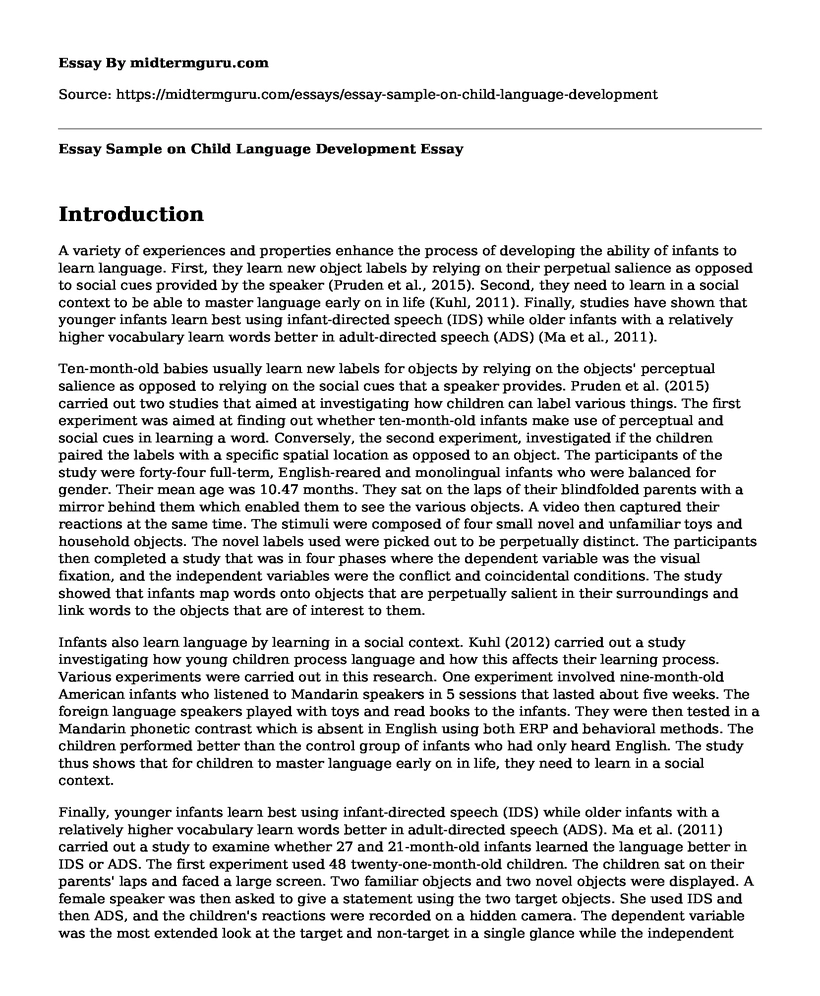Introduction
A variety of experiences and properties enhance the process of developing the ability of infants to learn language. First, they learn new object labels by relying on their perpetual salience as opposed to social cues provided by the speaker (Pruden et al., 2015). Second, they need to learn in a social context to be able to master language early on in life (Kuhl, 2011). Finally, studies have shown that younger infants learn best using infant-directed speech (IDS) while older infants with a relatively higher vocabulary learn words better in adult-directed speech (ADS) (Ma et al., 2011).
Ten-month-old babies usually learn new labels for objects by relying on the objects' perceptual salience as opposed to relying on the social cues that a speaker provides. Pruden et al. (2015) carried out two studies that aimed at investigating how children can label various things. The first experiment was aimed at finding out whether ten-month-old infants make use of perceptual and social cues in learning a word. Conversely, the second experiment, investigated if the children paired the labels with a specific spatial location as opposed to an object. The participants of the study were forty-four full-term, English-reared and monolingual infants who were balanced for gender. Their mean age was 10.47 months. They sat on the laps of their blindfolded parents with a mirror behind them which enabled them to see the various objects. A video then captured their reactions at the same time. The stimuli were composed of four small novel and unfamiliar toys and household objects. The novel labels used were picked out to be perpetually distinct. The participants then completed a study that was in four phases where the dependent variable was the visual fixation, and the independent variables were the conflict and coincidental conditions. The study showed that infants map words onto objects that are perpetually salient in their surroundings and link words to the objects that are of interest to them.
Infants also learn language by learning in a social context. Kuhl (2012) carried out a study investigating how young children process language and how this affects their learning process. Various experiments were carried out in this research. One experiment involved nine-month-old American infants who listened to Mandarin speakers in 5 sessions that lasted about five weeks. The foreign language speakers played with toys and read books to the infants. They were then tested in a Mandarin phonetic contrast which is absent in English using both ERP and behavioral methods. The children performed better than the control group of infants who had only heard English. The study thus shows that for children to master language early on in life, they need to learn in a social context.
Finally, younger infants learn best using infant-directed speech (IDS) while older infants with a relatively higher vocabulary learn words better in adult-directed speech (ADS). Ma et al. (2011) carried out a study to examine whether 27 and 21-month-old infants learned the language better in IDS or ADS. The first experiment used 48 twenty-one-month-old children. The children sat on their parents' laps and faced a large screen. Two familiar objects and two novel objects were displayed. A female speaker was then asked to give a statement using the two target objects. She used IDS and then ADS, and the children's reactions were recorded on a hidden camera. The dependent variable was the most extended look at the target and non-target in a single glance while the independent variable was the IDS and ADS. The same experiment was then conducted with 27-month old children. The tests showed that 21-year old infants learned the association between the novel objects and words when IDS was used and not ADS. Conversely, the 27-month old infants demonstrated that they learned the words in both tests.
Conclusion
In conclusion, it is evident that exposing children to specific experiences aid in enhancing their ability to learn the language. Perpetual salience aids in language learning better than social cues. Additionally, infants need to be placed in social settings since they will help them to learn the language better than isolated environments. Finally, parents should consider their children's age to determine whether they should use ADS or IDS to facilitate how they learn the language.
References
Kuhl, P. (2011). Early Language Learning and Literacy: Neuroscience Implications for Education. US National Library of Medicine National Institutes of Health Search Database, 5(3), 128-142. doi: 10.1111/j.1751-228X.2011.01121.
Ma, W., Golinkoff, R., Houston, D., & Hirsh-Pasek, K. (2011). Word Learning in Infant- and Adult-Directed Speech. Language Learning and Development, 7(3), 188-198. doi: 10.1080/15475441.2011.579839.
Pruden, S., Hirsh-Pasek, K., Golinkoff, R., & Hennon, E. (2015). The Birth of Words: Ten-Month-Olds Learn Words Through Perceptual Salience. US National Library of Medicine National Institutes of Health Search Database search Term Search, 77(2), 266-280. doi: [10.1111/j.1467-8624.2006.00869.
Cite this page
Essay Sample on Child Language Development. (2022, Sep 28). Retrieved from https://midtermguru.com/essays/essay-sample-on-child-language-development
If you are the original author of this essay and no longer wish to have it published on the midtermguru.com website, please click below to request its removal:
- Observation on the Level of Communication Between Parents and Children
- Essay Sample on Patty Plaintiff's Really Bad Week
- Paper Example on Integrating Piaget's Classroom Theory Into the Future of Kindergarten
- Depression in College Students: Annotated Bibliography
- Grandchildren's Play Reveals Different Levels of Psychomotor Development - Essay Sample
- Integrating Language Arts & Social Studies: 5-Day Lesson Plan - Essay Sample
- Single Parenting: A Challenging Yet Rewarding Journey - Essay Sample







